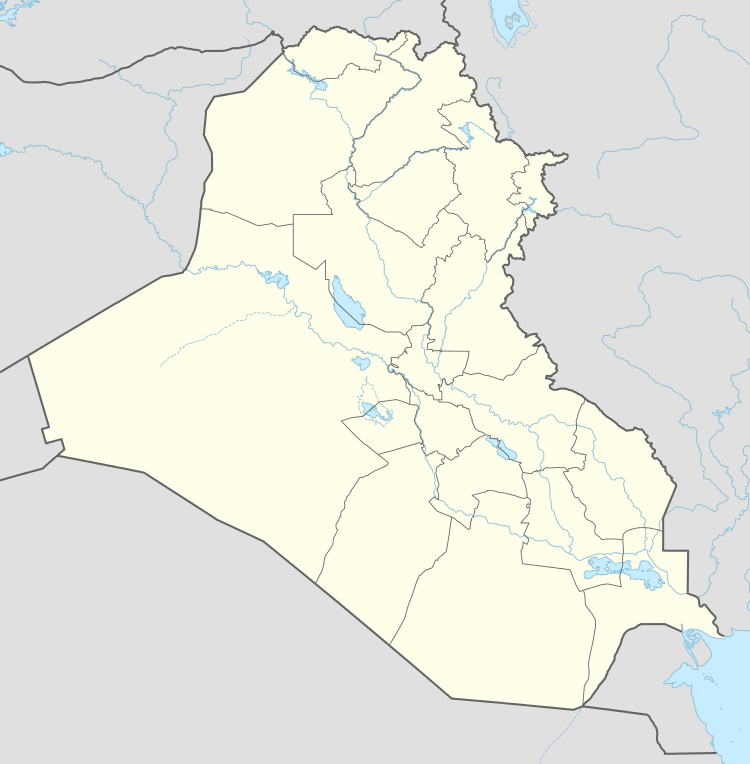Majnoon oil field
| Majnoon | |
|---|---|
 Location of Majnoon | |
| Country | Iraq |
| Location | near Basra |
| Offshore/onshore | onshore |
| Coordinates | 31°18′N 47°22′E / 31.3°N 47.36°E |
| Operator | Royal Dutch Shell |
| Service contractors |
Royal Dutch Shell Petronas |
| Field history | |
| Discovery | 1975 |
| Production | |
| Current production of oil | 200,000 barrels per day (~1.0×107 t/a) |
| Estimated oil in place | 12,600 million barrels (~1.72×109 t) |
| Producing formations | Upper Cretaceous |
Majnoon oil field is a super-giant oil field located 60 km (37 mi) from Basra, Basra Governorate in southern Iraq.[1] Majnoon is one of the richest oil fields in the world with an estimated 38 billion barrels of oil in place. The field was named Majnoon which means crazy in Arabic in reference to excessive amount of oil in a dense area.[2]
History
The field was discovered by Braspetro, a Brazilian company in 1975, under the leadership of Bolivar Montenegro Guerra in a shallow Upper Cretaceous formation.[2] Development came to a halt in 1980 during the engineering phase of the project, due to Iran–Iraq War, particularly Operation Kheibar. At the time, Braspetro had finished drilling of 20 wells and pressed 14 drilling rigs into service. In the course of the war, Iran occupied and sabotaged the area. After the war, Southern Oil Company of Iraq restarted the production. In 1990's, Total S.A. of France negotiated a development contract with Saddam Hussein but was unable to sign the deal due to United Nations sanctions imposed on Iraq. The deal was eventually annulled by Hussein in 2002. Due to 2003 Iraq War, production was reduced to 46,000 barrels per day (7,300 m3/d).[2] In 2007, Total and Chevron signed an agreement with Iraqi government to explore Majnoon field.[3]
On December 11, 2009, the Iraqi government awarded a license to a joint venture from Royal Dutch Shell and Petronas to take over operations at Majnoon Oilfield, and triple production from the estimated reserve of nearly 12.6 billion barrels (2.00×109 m3) at a fee rate of $1.39/barrel.[4][5] The consortium was awarded the contract out of 44 international companies, participating in the auction, with China National Petroleum Corporation (CNPC), ExxonMobil, Sinochem Corporation, Total specifically bidding on Majnoon field.[6] The finalist alliance of CNPC and Total offering $1.75/barrel lost the bid.[3] The deal intends a 20-year service and development of the field.[7][8] The contract was approved by Council of Ministers of Iraq on January 5, 2010.[9]
Licences
The operator Shell holds 45% stake in all licences, while Petronas and Iraqi Ministry of Oil hold 30% and 25% of interest.[10] According to company officials, the project will require tens of billions of dollars over the 20-year period.[11]
Reservoir
Majnoon's first pay zone consists of Upper Cretaceous which proved 4,000 barrels (640 m3) of oil per day in 1976. Mishrif carbonates, Nahr Umr sands (Middle Cretaceous) and Shuaiba carbonates and Zubair sands (Lower Cretaceous) form the pay zones.[2]
Production
According to the deal, the consortium will increase production to a peak 1.8 million barrels (290,000 m3) of oil per day within seven-year period.[1] Majnoon was the first Iraqi field out of 10 major ones offered to international companies for development.[2] The contract with Shell and Petronas includes drilling over 40 production wells, construction of three gas separation stations and two crude oil processing refineries with overall capacity of 100,000 barrels per day (16,000 m3/d).[1][2] The official start date was March 1, 2010.[12] In the Phase I of the project, the consortium intends to increase the production from 45,000 to 175,000 barrels per day (27,800 m3/d) within two-year period.[1][13]
The production at Majnoon will move Iraq from the current 11th place to the 3rd among oil producing nations after Saudi Arabia and Iran.[12] The country sits on 150 billion of oil and currently produces 2.5 million barrels per day (400,000 m3/d). Iraq expects to top the oil production to 7 million barrels per day (1,100,000 m3/d) within six years, thus competing with Saudi Arabia.[2]
See also
References
- 1 2 3 4 Adal Mirza (2010-04-25). "Iraq agrees Majnoon oilfield development plan". MEED. Middle East business intelligence since 1957. Retrieved 2010-05-21.
- 1 2 3 4 5 6 7 "Offshore-technology.com Majnoon Field, Iraq". Retrieved 2010-05-21.
- 1 2 Williams, Timothy (2009-12-11). "Under Tight Security, Iraq Sells Rights to Develop 2 Oil Fields". The New York Times. Retrieved 2009-12-11.
- ↑ "Iraq oil development rights contracts awarded". BBC News. 2009-12-11. Retrieved 2009-12-11.
- ↑ "Shell signs initial deal to develop Majnoon oilfield". France 24. 2009-12-12. Retrieved 2009-12-11.
- ↑ "Iraq oil development rights contracts awarded". BBC News. 2009-12-11. Retrieved 2010-05-21.
- ↑ Hassan Hafidh (2009-12-07). "Iraq's Giant Majnoon Oil Field to Top Friday's Auction". Rigzone. Retrieved 2010-05-21.
- ↑ Hassan Hafidh; James Herron (2009-12-11). "Shell Consortium Wins Contract on Iraq's Majnoon Oil Field". Wall Street Journal. Retrieved 2010-05-21.
- ↑ "Iraq and Shell consortium sign the Majnoon Oilfield contract" (Press release). Shell. 2010-01-17. Retrieved 2010-05-21.
- ↑ "Royal Dutch Shell plc welcomes Iraq Majnoon contract award" (Press release). Royal Dutch Shell. 2009-12-11. Retrieved 2009-12-11.
- ↑ Missy Ryan (2009-12-20). "Iraq, Shell ink deal on supergiant Majnoon field". Reuters. Retrieved 2010-05-21.
- 1 2 "Shell to Boost Iraq Majnoon Oil Output, Eyes Gas". Iraq Business News. 2010-03-30. Retrieved 2010-05-21.
- ↑ Luke Pachymuthu (2010-03-29). "Iraq's Majnoon oilfield to hit 175,000 boed in 2012". Reuters. Retrieved 2010-05-21.
External links
Coordinates: 31°3′58″N 47°36′39″E / 31.06611°N 47.61083°E